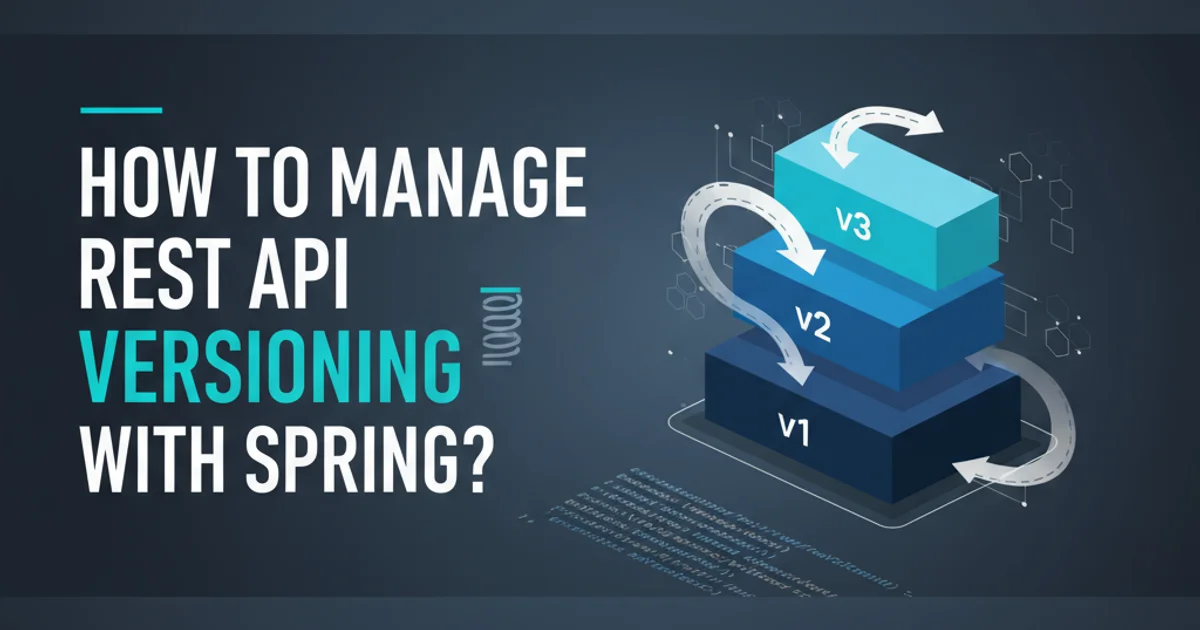How to manage REST API versioning with spring?
Categories:
Mastering REST API Versioning in Spring Boot Applications

Explore various strategies for versioning your REST APIs in Spring Boot, ensuring backward compatibility and smooth evolution of your services.
As your applications evolve, so do your APIs. Managing changes to your REST APIs while maintaining backward compatibility for existing clients is a critical challenge. API versioning allows you to introduce new features or modify existing ones without breaking older integrations. This article delves into common strategies for versioning REST APIs within a Spring Boot ecosystem, providing practical examples and best practices.
Why API Versioning is Essential
API versioning is not just a good practice; it's a necessity for any long-lived API. Without it, every change, no matter how small, risks disrupting client applications. This can lead to significant development overhead, client frustration, and a reluctance to adopt new features. Proper versioning enables you to:
- Maintain Backward Compatibility: Old clients can continue to use the older API version without modification.
- Introduce New Features: Develop and deploy new API versions with enhanced functionality or improved data models.
- Facilitate Gradual Migration: Clients can migrate to newer versions at their own pace.
- Reduce Downtime: Avoid forced upgrades that could lead to service interruptions for clients.
- Improve Developer Experience: Clear versioning makes it easier for developers to understand API changes and plan their integrations.
flowchart TD
A[API Evolution Start] --> B{New Feature / Change Request}
B --> C{Is it a breaking change?}
C -->|Yes| D[Introduce New API Version (e.g., v2)]
C -->|No| E[Update Existing API Version (e.g., v1.1)]
D --> F[Clients Migrate to v2]
E --> G[Clients Continue Using v1]
F --> H[Deprecate Old Version (v1)]
G --> H
H --> I[Remove Old Version (v1)]
I --> J[API Evolution End]API Versioning Decision Flow
Common Versioning Strategies in Spring Boot
Spring Boot offers several ways to implement API versioning. Each strategy has its pros and cons, and the best choice often depends on your project's specific requirements and client base.
1. URI Versioning (Path Versioning)
This is one of the most straightforward and widely adopted methods. The API version is included directly in the URI path. It's easy to understand and implement, and it's visible to clients.
Pros:
- Simple to implement and understand.
- Clear and explicit versioning.
- Easy to cache responses based on the URI.
Cons:
- Violates the REST principle of a resource having a single URI (though often considered a pragmatic compromise).
- Can lead to URI proliferation if many versions exist.
@RestController
@RequestMapping("/api")
public class UserController {
@GetMapping("/v1/users")
public String getUsersV1() {
return "List of users from V1";
}
@GetMapping("/v2/users")
public String getUsersV2() {
return "List of users from V2 with new fields";
}
}
URI Versioning Example in Spring Boot
2. Request Parameter Versioning
With this approach, the API version is passed as a query parameter in the request URL. This keeps the base URI clean but might be less explicit than path versioning.
Pros:
- Keeps the base URI clean.
- Easy to implement.
Cons:
- Query parameters are often optional, which might lead to ambiguity if not enforced.
- Can be overlooked by clients if not well-documented.
@RestController
@RequestMapping("/api/users")
public class UserController {
@GetMapping(params = "version=1")
public String getUsersParamV1() {
return "List of users from V1 (param)";
}
@GetMapping(params = "version=2")
public String getUsersParamV2() {
return "List of users from V2 (param) with new fields";
}
}
Request Parameter Versioning Example
3. Header Versioning
This method involves sending the API version in a custom HTTP header (e.g., X-API-Version or Accept-Version). This is often considered a more RESTful approach as the URI identifies the resource, and the header specifies the representation version.
Pros:
- Keeps the URI clean and truly identifies the resource.
- More aligned with REST principles.
Cons:
- Not as easily discoverable as URI versioning.
- Requires clients to explicitly set a custom header.
@RestController
@RequestMapping("/api/users")
public class UserController {
@GetMapping(headers = "X-API-Version=1")
public String getUsersHeaderV1() {
return "List of users from V1 (header)";
}
@GetMapping(headers = "X-API-Version=2")
public String getUsersHeaderV2() {
return "List of users from V2 (header) with new fields";
}
}
Header Versioning Example
4. Content Negotiation (Accept Header Versioning)
This strategy leverages the Accept HTTP header, where clients specify the desired media type, including a version. For example, Accept: application/vnd.company.app-v1+json. This is often considered the most RESTful approach.
Pros:
- Highly RESTful, leveraging standard HTTP headers.
- Allows for different representations of the same resource.
Cons:
- More complex for clients to implement.
- Can be harder to test and debug.
@RestController
@RequestMapping("/api/users")
public class UserController {
@GetMapping(produces = "application/vnd.company.app-v1+json")
public String getUsersAcceptV1() {
return "List of users from V1 (Accept header)";
}
@GetMapping(produces = "application/vnd.company.app-v2+json")
public String getUsersAcceptV2() {
return "List of users from V2 (Accept header) with new fields";
}
}
Content Negotiation Versioning Example
Best Practices for API Versioning
Beyond choosing a strategy, adhering to best practices ensures a smooth versioning experience:
- Document Everything: Clearly document your API versions, changes, deprecation schedules, and migration guides.
- Deprecation Policy: Establish a clear policy for deprecating and eventually removing old API versions. Communicate this well in advance to clients.
- Backward Compatibility: Strive for backward compatibility whenever possible. Only introduce new versions for breaking changes.
- Minor vs. Major Versions: Use major versions (v1, v2) for breaking changes and minor versions (v1.1, v1.2) for non-breaking additions or bug fixes.
- Default Version: Provide a default version if no version is specified by the client, typically the latest stable version.
- Consistent Naming: Maintain consistent naming conventions across all API versions.
- Testing: Thoroughly test all API versions to ensure they function as expected and that migrations are smooth.
Implementing API versioning in Spring Boot is a crucial step towards building robust and maintainable microservices. By carefully selecting a strategy and following best practices, you can ensure your APIs evolve gracefully, providing a stable and predictable experience for your consumers.